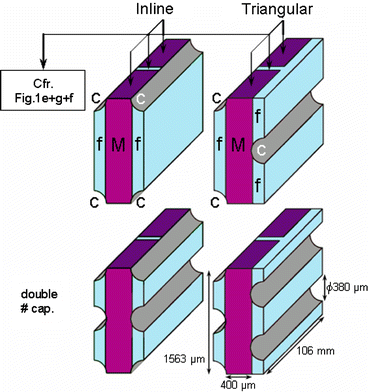Three-dimensional numerical modeling and computational fluid dynamics simulations to analyze and improve oxygen availability in the AMC bioartificial liver
- PMID: 17031599
- PMCID: PMC1705524
- DOI: 10.1007/s10439-006-9169-6
Three-dimensional numerical modeling and computational fluid dynamics simulations to analyze and improve oxygen availability in the AMC bioartificial liver
Abstract
A numerical model to investigate fluid flow and oxygen (O(2)) transport and consumption in the AMC-Bioartificial Liver (AMC-BAL) was developed and applied to two representative micro models of the AMC-BAL with two different gas capillary patterns, each combined with two proposed hepatocyte distributions. Parameter studies were performed on each configuration to gain insight in fluid flow, shear stress distribution and oxygen availability in the AMC-BAL. We assessed the function of the internal oxygenator, the effect of changes in hepatocyte oxygen consumption parameters in time and the effect of the change from an experimental to a clinical setting. In addition, different methodologies were studied to improve cellular oxygen availability, i.e. external oxygenation of culture medium, culture medium flow rate, culture gas oxygen content (pO(2)) and the number of oxygenation capillaries. Standard operating conditions did not adequately provide all hepatocytes in the AMC-BAL with sufficient oxygen to maintain O(2) consumption at minimally 90% of maximal uptake rate. Cellular oxygen availability was optimized by increasing the number of gas capillaries and pO(2) of the oxygenation gas by a factor two. Pressure drop over the AMC-BAL and maximal shear stresses were low and not considered to be harmful. This information can be used to increase cellular efficiency and may ultimately lead to a more productive AMC-BAL.
Figures





References
-
- {'text': '', 'ref_index': 1, 'ids': [{'type': 'DOI', 'value': '10.1006/mben.1998.0105', 'is_inner': False, 'url': 'https://doi.org/10.1006/mben.1998.0105'}, {'type': 'PubMed', 'value': '10935754', 'is_inner': True, 'url': 'https://pubmed.ncbi.nlm.nih.gov/10935754/'}]}
- Balis U. J., Behnia K., Dwarakanath B. et al. (1999) Oxygen consumption characteristics of porcine hepatocytes Metab. Eng. 1(1): 49–62 - PubMed
-
- None
- Bird R. B., Stewart W. E., Lightfoot E. N., (1960) Transport Phenomena. John Wiley and Sons, New York
-
- {'text': '', 'ref_index': 1, 'ids': [{'type': 'PubMed', 'value': '8641815', 'is_inner': True, 'url': 'https://pubmed.ncbi.nlm.nih.gov/8641815/'}]}
- Catapano G., (1996) Mass transfer limitations to the performance of membrane bioartificial liver support devices Int. J. Artif. Organs 19(1): 18–35 - PubMed
-
- {'text': '', 'ref_index': 1, 'ids': [{'type': 'DOI', 'value': '10.1021/bp9800182', 'is_inner': False, 'url': 'https://doi.org/10.1021/bp9800182'}, {'type': 'PubMed', 'value': '9622534', 'is_inner': True, 'url': 'https://pubmed.ncbi.nlm.nih.gov/9622534/'}]}
- Catapano G., De Bartolo L., (1998) Technique for the kinetic characterization of the metabolic reactions of hepatocytes in adhesion culture Biotechnol. Prog. 14(3): 500–507 - PubMed
-
- {'text': '', 'ref_index': 1, 'ids': [{'type': 'DOI', 'value': '10.1016/j.memsci.2003.10.040', 'is_inner': False, 'url': 'https://doi.org/10.1016/j.memsci.2003.10.040'}]}
- Catapano G., Hornscheidt R., Wodetzki A. et al. (2004) Turbulent flow technique for the estimation of oxygen diffusive permeability of membranes for the oxygenation of blood and other cell suspension J. Membr. Sci. 230: 131–139
Publication types
MeSH terms
Substances
LinkOut - more resources
Full Text Sources
Other Literature Sources

